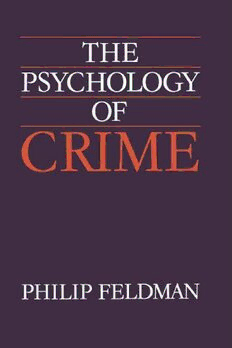
The Psychology of Crime: A Social Science Textbook PDF
Preview The Psychology of Crime: A Social Science Textbook
The Psychology of Crime is an overview of current theory and research in criminology. While its emphasis is largely psychological, it also gives considerable weight to sociological perspectives, and succeeds in integrating the two approaches neatly to discuss the scholarship on the criminal justice system and criminal behavior. The book begins by laying out the empirical data on offenses, offenders, the police, and the courts. The definition of criminal behavior and the workings of the criminal justice system determine who is called a criminal and, in turn, who should be studied in crim- inology. In setting out the main findings for which theories of crime must account, Philip Feldman does not neglect the possibility that the operation of the criminal justice system may both compound the crime problem and make explanations more difficult. The second section of this work describes and assesses the major approaches to the explanation of crime. Beginning with biological factors and proceeding through individual differences, including intel- ligence, personality, and mental disorder, it moves on to childhood behaviors and experiences within the home, school, and with peers, and social factors of economics, culture, and community. This section then provides a broad overview of sociological theories of crime and demonstrates the overlaps between these and several psychological approaches. The final chapter in section II gives a full account of cognitive/behavioral theories, focusing on social learning and on rational choice theory. The final section covers the range of social attempts to respond to offenses and offenders. Feldman examines the methods in current use, from probation to the death penalty, as well as the psychological and social impact of imprisonment. He reviews psychological treatments for offenders, mainly behavioral in emphasis, and discusses a range of attempts at crime deterrence. This book systematically examines the evidence for hopes that criminal behavior can be controlled and changed. Its breadth of coverage and firm base in psychology are unique in the current literature making it especially valuable as a text for undergraduate and postgraduate courses across the social sciences. The psychology of crime The psychology of crime A social science textbook Philip Feldman University of Leeds CAMBRIDGE UNIVERSITY PRESS PUBLISHED BY THE PRESS SYNDICATE OF THE UNIVERSITY OF CAMBRIDGE The Pitt Building, Trumpington Street, Cambridge CB2 1RP, United Kingdom CAMBRIDGE UNIVERSITY PRESS The Edinburgh Building, Cambridge CB2 2RU, UK http: / /www.cup.cam.ac.uk 40 West 20th Street, New York, NY 10011-4211, USA http: //www.cup.org 10 Stamford Road, Oakleigh, Melbourne 3166, Australia © Cambridge University Press 1993 This book is in copyright. Subject to statutory exception and to the provisions of relevant collective licensing agreements, no reproduction of any part may take place without the written permission of Cambridge University Press. First published 1993 Reprinted 1996,1998 Typeset in Palatino A catalogue record for this book is available from the British Library Library of Congress Cataloguing-in-Publication Data is available ISBN 0-521-33120-X hardback ISBN 0-521-33732-1 paperback Transferred to digital printing 2002 To my family Contents Preface page xi PART I DESCRIPTION 1 1 Offences 3 1.1 Definitions 3 1.2 The index crimes 6 1.3 Other offences 12 1.4 Other categories of crime 15 1.5 Historical trends in crime 22 1.6 How much crime: methods 23 1.7 How much crime: results 30 1.8 International comparisons 36 2 Offenders and victims 42 2.1 Offenders: methods of study 42 2.2 Offenders: results 53 2.3 Victims 73 3 The police 80 3.1 History 80 3.2 Police functions 82 3.3 Police effectiveness 88 3.4 Police discretion 90 3.5 The police as people 95 4 The courts 105 4.1 The trial 105 4.2 The sentence 123 4.3 The insanity defense 132 vii viii Contents PART II EXPLANATION 137 Biological factors 139 5.1 Anatomical correlates 139 5.2 Sex differences 141 5.3 Chromosomal abnormalities 144 5.4 Genetic inheritance 146 Individual differences 154 6.1 Intelligence 154 6.2 Personality 157 6.3 Mental disorder 171 Childhood development 184 7.1 Introduction 184 7.2 Moral development 184 7.3 Training children 188 7.4 Families and crime 195 7.5 Childhood variables and crime 201 7.6 Schools 205 7.7 Peers 209 7.8 The media and crime 212 Social and economic theories and factors 218 8.1 Introduction 218 8.2 Sociological theories of crime 219 8.3 Cultural influences 234 8.4 Community 239 8.5 Ethnicity 243 8.6 Economic factors 251 The cognitive-behavioral approach 262 9.1 Introduction 262 9.2 Social learning theory of crime: a general framework 264 9.3 Crimes against property 283 9.4 Offences against persons 291 9.5 Rational choice theory 311 9.6 Cognitive-behavioral approaches: appraisal 319 9.7 Concluding comment 327
